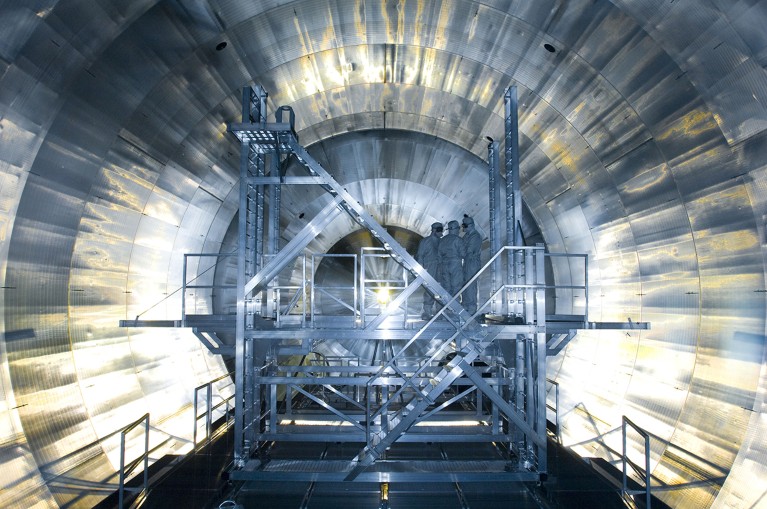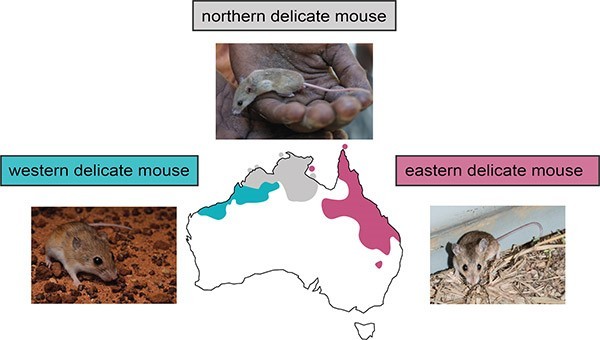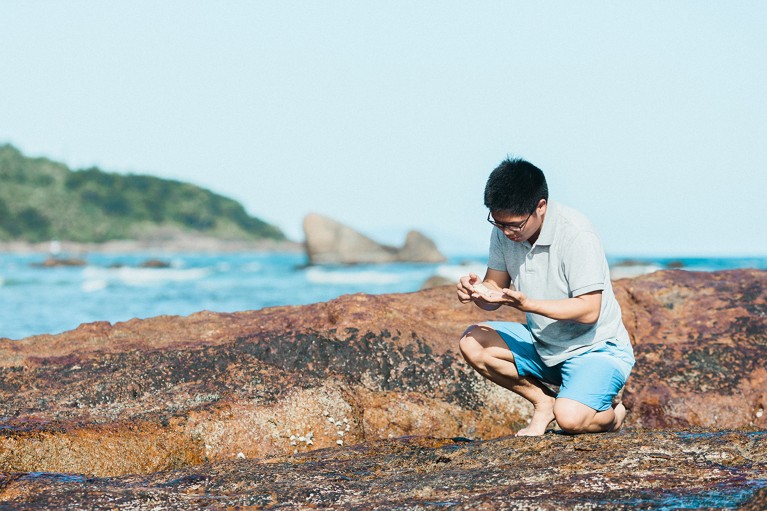Hello Nature readers, would you like to get this Briefing in your inbox free every day? Sign up here.

The Karlsruhe Tritium Neutrino (KATRIN) detector uses the radioactive decay of tritium to measure the neutrino’s mass.Credit: KIT/KATRIN Collaboration
Physicists gathered this week to compare notes on how to weigh neutrinos, one of the most mysterious of the elementary particles. Currently, only one experiment in the world has a shot at making such a measurement — the massive, Zeppelin-shaped Karlsruhe Tritium Neutrino (KATRIN) detector in Germany. The researchers hope to build scaled-up versions of alternative experimental techniques that could eventually compete with KATRIN, or even improve on it. “We worry that KATRIN, even though it’s a great experiment, may not be able to determine the mass,” says physicist Matteo Borghesi.
An explosive rise in dengue cases in Brazil has pushed it to become the first country to roll out a public vaccination campaign against the mosquito-borne disease. In the first two months of 2024, the country registered more than a million cases — a record for this period. Researchers say the campaign is an important addition to the fight against dengue, but they warn that the effort is too modest to solve the immediate crisis. “To have an impact on the rates, we would need to have mass vaccination,” says infectious-disease specialist Ana Lúcia de Oliveira.
Brazil’s record dengue surge: why a vaccine campaign is unlikely to stop it
A satellite set to launch today will help tackle the most powerful greenhouse gas with a combination of artificial intelligence and ‘radical transparency’. Developed by a coalition of environmentalists, scientists and aerospace engineers, MethaneSAT will pinpoint methane leaks and use Google algorithms to map oil and gas infrastructure where leaks can originate — information that many fossil fuel companies keep to themselves. What sets MethaneSAT apart is its resolution. “This will be the first time that we have ever had this type of information for any greenhouse gas,” says Steven Hamburg, chief scientist at the Environmental Defense Fund, which led the satellite’s development.
A check on more than 7 million scholarly publications labelled with unique digital object identifiers (DOIs) reveals that 28% are missing from online archives. “Many people have the blind assumption that if you have a DOI, it’s there forever,” says Mikael Laakso, who studies scholarly publishing. But it costs money to preserve digital content, and archiving involves infrastructure, technology and expertise that many smaller organizations do not have access to.
Infographic of the week

Australia’s smallest rodent, the delicate mouse or Molinipi (Pseudomys delicatulus), was thought to be a single species with a huge range. Now, thanks to genomic sequencing, data on reproductive traits and high-resolution computed tomography scans, we know there are three. They now include the ‘western delicate mouse’ (Pseudomys pilbarensis), called Kalunyja in the Kariyarra language — and the ‘eastern delicate mouse’ (Pseudomys mimulus): Kalla, in the Wik-Mungkan language. “By giving these species their own names, we’re taking the first step toward ensuring they’re given the right conservation attention,” says evolutionary biologist Emily Roycroft, who led the research. (The Conversation | 4 min read)
Reference: Molecular Ecology paper (Emily Roycroft, with photos by Ian Bool, Yugul Mangi Rangers and Justin Wright)
Features & opinion
The COVID-19 pandemic slingshotted many of us into a world where working from home, at least some of the time, is the norm. Researchers are racing to understand the full implications — for science and for everything else. So far, the evidence from studies both before and after the pandemic is mixed: at least some studies suggest that working remotely might have a slightly negative impact on productivity and generating ideas, while improving job satisfaction and employee retention. Among scientists, there are signs that those based at the same site make more breakthrough discoveries.
Primatologist Christophe Boesch, alongside his wife and collaborator Hedwige Boesch-Achermann, did influential long-term research on wild West African chimpanzees (Pan troglodytes verus) in Taï National Park, Côte d’Ivoire. Boesch thought that scientists routinely underestimated the cognitive complexity of chimpanzees and that studying them in captivity tended to have little relevance to understanding their behaviour in the wild. He would tell his students, “Go to the field,” write primatologists Kathelijne Koops and Richard Wrangham. “Observe the chimpanzees and don’t worry about the textbooks — the chimpanzees will teach you!” Boesch has died, aged 72.
The experiences of scientists who offer expert testimony in US court cases suggest it can be rewarding but bruising. “What they’re trying to do is show that you are a shoddy scientist. And that is really hard to take,” says epidemiologist Beate Ritz about her time testifying in court. Researchers can also face attacks outside the courtroom. But some researchers feel an ethical responsibility to share their expertise, especially if it protects people’s health. And the work can be well paid: Ritz earned US$500 an hour for reviewing documents and preparing, and $5,000 per day when testifying at trial.
Where I work

Yang Li is a geochemist at Peking University in Beijing.Credit: Jeremy Walter Grinan for Nature
Geochemist Yang Li investigates how some minerals form in spurts, over a few tens of thousands of years or less — leaving ‘mineral zones’ in rocks akin to the seasonal growth rings of trees. “In this image, I’m collecting granite rock samples in the coastal Hainan region of China,” he says. “My current research at Peking University in Beijing focuses on identifying what controls this rapid and pulsing nature of mineral ore formation so that we can identify where metals in Earth’s crust are enriched and can be mined economically.” (Nature | 2 min read) (Jeremy Walter Grinan for Nature)
On Friday, in our penguin-spotting game, Leif Penguinson was embracing Scotland’s natural beauty near the coastal cliffs of Handa Island. Did you find the penguin? When you’re ready, here’s the answer.
Thanks for reading,
Flora Graham, senior editor, Nature Briefing
With contributions by Smriti Mallapaty and Sarah Tomlin
Want more? Sign up to our other free Nature Briefing newsletters:
• Nature Briefing: Anthropocene — climate change, biodiversity, sustainability and geoengineering
• Nature Briefing: AI & Robotics — 100% written by humans, of course
• Nature Briefing: Cancer — a weekly newsletter written with cancer researchers in mind
• Nature Briefing: Translational Research covers biotechnology, drug discovery and pharma

